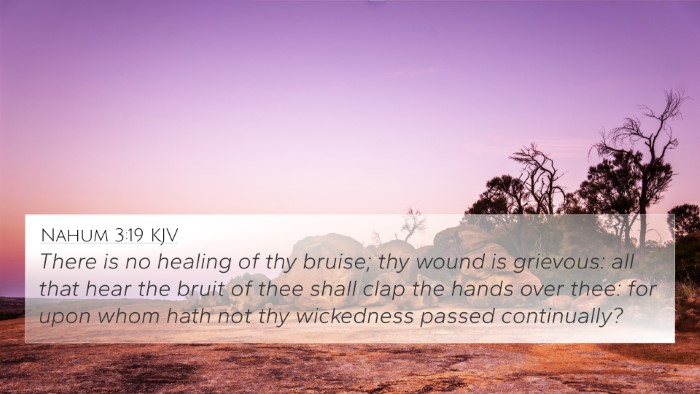Understanding Isaiah 1:6
Isaiah 1:6 (KJV): "From the sole of the foot even unto the head there is no soundness in it; but wounds, and bruises, and putrifying sores: they have not been closed, neither bound up, neither mollified with ointment."
This verse conveys a profound message about the spiritual and moral disarray of Israel. The imagery of the body is used to illustrate the complete corruption and suffering that permeates the nation.
Summary of Key Insights
- Comprehensive Condition: The description of the body from head to toe symbolizes the totality of Israel's afflictions. Matthew Henry explains that the image emphasizes there is "no soundness," pointing to a deep-rooted issue affecting the entirety of the nation.
- Spiritual vs. Physical Wounds: Albert Barnes notes that the "wounds" and "bruises" signify not only physical ailments but also spiritual failures and moral decay. This interpretation highlights that physical suffering may reflect deeper spiritual issues.
- Neglect of Healing: Adam Clarke elaborates that the absence of healing or care ("they have not been closed") indicates a failure to address Israel's sins. The lack of "ointment" symbolizes God's grace and mercy being unutilized or rejected by the people.
Context of Isaiah 1:6
Isaiah 1:6 is set in a broader context where the prophet Isaiah addresses the nation of Israel's rebellion against God. The previous verses depict the people's disobedience and the futility of their religious practices, which are not accompanied by genuine repentance.
Bible Verse Cross-References
- Jeremiah 30:12-13: Both verses illustrate a similar theme of incurable wounds and the nation's suffering due to sin.
- Luke 10:30-34: The Good Samaritan parable reflects the idea of mercy and healing, contrasting the neglect seen in Isaiah.
- Matthew 15:14: Jesus references the blind leading the blind, akin to Israel's leaders failing to provide spiritual guidance.
- Romans 3:23: "For all have sinned, and come short of the glory of God." This New Testament verse underscores the universality of sin that parallels the condition described in Isaiah.
- James 4:8: This verse invites healing through repentance, reminding us that restoration is possible.
- Isaiah 53:5: Foretelling of Jesus, it discusses healing and the connection between suffering and redemption.
- 2 Chronicles 7:14: Calls for humility and prayer as the means for healing a nation’s afflictions.
Thematic Connections in Scripture
The examination of Isaiah 1:6 encourages us to explore thematic connections through the Bible, such as the relationship between physical affliction and spiritual malaise. The concept of seeking healing resonates across both the Old and New Testaments, providing a framework for understanding God's mercy.
Comparative Bible Verse Analysis
In conducting a comparative analysis, one may notice how various biblical figures address issues of spiritual integrity. For example, the lamentation of Jeremiah complements the criticisms presented by Isaiah, creating an inter-biblical dialogue that deepens our understanding of sin and repentance.
Tools for Bible Cross-Referencing
Utilizing tools like a Bible concordance or a Bible cross-reference guide can facilitate deeper study into these connections. Understanding the relationships between verses enhances one's grasp of scripture and underscores recurring themes, such as redemption and the necessity for repentance.
Conclusion
Isaiah 1:6 serves as a poignant reminder of the consequences of turning away from God and the healing that awaits those who genuinely seek restoration. By cross-referencing with other scriptures, believers can deepen their understanding of God's message and His desire for His people to be whole—physically, spiritually, and morally.

















